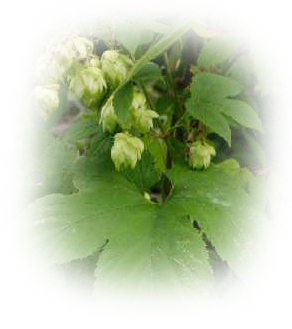Hops Asparagus
|
|
| Humulus lupulus Cannabidaceae
During the Roman Empire Pliny the Elder named a wild hop plant Lupus Salictarius or willow wolf for its growing habit amongst the willows; twinning itself and strangling them as would a wolf to a lamb. He wrote Naturalis Historia an encyclopedic work that survived the fall of the Roman Empire. Carl Linnaeus renamed the plant Humulus lupulus Swedish for hops, hoppan “to climb” in Anglo-Saxon and French for houblon, keeping the wolfish behavior in lupulus. The Romans cultivated the hops as a vegetable, sold as young shoots on the market; it was only in the ninth century that the hop vines where cultivated to flavor and preserve beer in Europe. Britain obliged in the sixteenth century, sleep pillows stuffed with hops also became popular. |
|
|
In the Garden
Sunny to partial shade, moderately rich and moist soil, dioecious herbaceous perennial climber, entwines clockwise. Leaves are opposite, 3, 5 or 7 lobed with a broad terminal lobe, coarsely serrated with a long petiole. Flowers are indistinct greenish, yellow catkins male and female on different plants in late summer. The male flower (Nettle Hops) in loose clusters, the female (Strobiles) in shorter, rounder heads developing in papery cones encapsulating the fruit used in beer making. The stems are hollow and are covered with anvil shaped hooks that make this an ideal climber for screening views, can be quite aggressive. Prone to Verticillium wilt and downy mildew, propagation should be from female plants only, softwood cuttings and root division where strict hygiene should be practiced. Sterilize tools with bleach and/or alcohol after each cut. Mornings are best as they lose water quickly and wilt; plant 3 feet apart on a support. Each fall cut plant back, amend soil with manure or compost; harvest cones and dry in a warm airy place. To harvest hop asparagus, in the spring time leave the 3 strongest leaders to climb and cutback any new growth to strengthen the existing plant – all done by hand. Leaves, stem and terminal bud are all edible, tasting like asparagus with a spinach undertone. |
|



